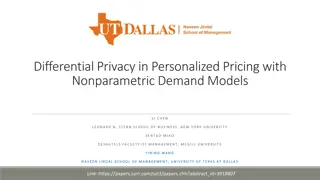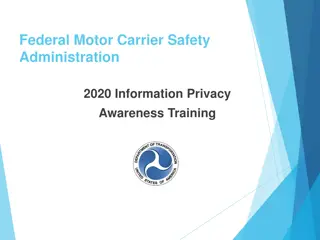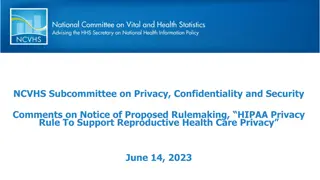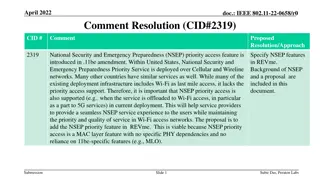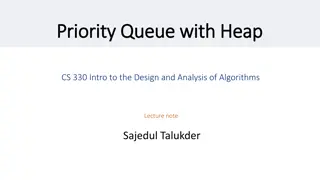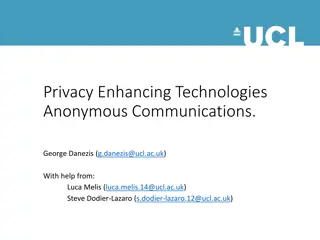Onions for Sale: Enhancing Privacy with Paid Priority Network Service
In this comprehensive presentation, the challenges faced by Tor network regarding speed and relay overload are discussed. The proposed solution suggests allowing users to pay for better performance, ultimately aiding in network growth. The need for prioritizing traffic is highlighted to ensure equitable access for all users. The potential impact of user payments on network performance and the industry is also analyzed, providing insightful perspectives on enhancing privacy in online communication.
Uploaded on Feb 23, 2025 | 1 Views
Download Presentation

Please find below an Image/Link to download the presentation.
The content on the website is provided AS IS for your information and personal use only. It may not be sold, licensed, or shared on other websites without obtaining consent from the author.If you encounter any issues during the download, it is possible that the publisher has removed the file from their server.
You are allowed to download the files provided on this website for personal or commercial use, subject to the condition that they are used lawfully. All files are the property of their respective owners.
The content on the website is provided AS IS for your information and personal use only. It may not be sold, licensed, or shared on other websites without obtaining consent from the author.
E N D
Presentation Transcript
Onions for Sale: Putting Privacy on the Market Rob Jansen Aaron Johnson Paul Syverson U.S. Naval Research Laboratory Presented by: Alessandro Acquisti Financial Cryptography 2013
Problem: Tor is slow Web (320 KiB) Bulk (5 MiB) File download distributions over Tor and PlanetLab
Problem: Few, overloaded Tor relays Total relay bandwidth Advertised bandwidth Bandwidth history 3500 3000 2500 Bandwidth (MiB/s) 2000 1500 1000 500 0 Jan 2013 Feb 2013 Dec 2012 The Tor Project https://metrics.torproject.org/ Top 15 Exit Relays Exit Probability 7.25% 6.35% 5.92% 3.60% 3.35% 3.32% 3.26% 2.32% 2.23% 2.22% 2.05% 1.93% 1.82% 1.67% 1.53% Total 48.82% Advertised Bandwidth 0.87% 0.93% 1.48% 0.66% 1.17% 1.18% 0.65% 0.36% 0.69% 0.41% 0.40% 0.65% 0.39% 0.35% 0.40% Nickname chaoscomputerclub18 chaoscomputerclub20 herngaard chomsky dorrisdeebrown bolobolo1 rainbowwarrior sdnettor01 TheSignul raskin bouazizi assk kramse BostonUCompSci bach compass.torproject.org
Problem: Other solutions often provide weak traffic security Examples Virtual Private Networks Often leak communication partners [1] Not designed for a strong adversary Single point of trust File upload sites Inherently reveal connection with upload site Single point of trust Filesharing seedboxes Connections to seedboxes are observed Single point of trust
Solution: Allow users to pay Tor for preferential network service. Use the money to grow the Tor network. $ $ 1. User pays for e- cash. 2. Payment funds relay. prioritized normal 3. User sends relays on onion-routing circuit e-cash to obtain priority.
$ Tor has an estimated 500,000 unique users per day. How many new and existing users would pay for better performance? SSL VPN: $506 million business in 2008 [2] File upload sites: estimated 7% of Internet traffic in 2011 [3] BitTorrent: estimated 14.3% of Internet traffic in 2011 [3] and 52% of Tor traffic in 2010 [4].
prioritized normal How to prioritize? Proportional Differentiated Services [5] Why prioritize? Requiring all users to pay hasn t worked in the past [6]. Prioritizing traffic ensures users with little money or low risk will continue using Tor.
Anonymity Users identify themselves as paying or non-paying to relays on the circuit. An exit can link the destination to a the paying or non-paying group of users. Paying users Tor Non-paying users Users must be aware of the risk of joining the new paying group. As more join, it becomes more anonymous.
Technical challenge: Accepting payments Payments should be possible without requiring user identification or traceability to Tor. Third-party payment processor Google Wallet PayPal Amazon Payments Bitcoin Tor currently accepts donations in such forms (excepting Bitcoin)
Technical challenge: growing the Tor network $ Added capacity should offset the relative slowdown of non-paying users. Tor should not centralize control and liability of relays. Torservers.net a separate non-profit that takes money to run relays - provides a model for using payments. How will existing relay operators respond to new monetary incentives?
References 1. Appelbaum, J., Ray, M., Koscher, K., Finder, I., vpwns: Virtual pwned networks . FOCI, 2012. 2. Girard, J., Magic Quadrant for SSL VPNs . Gartner Research, 2008. 3. Technical report: An Estimate of Infringing Use of the Internet . Envisional, 2011. 4. Abdelberi, C. et al., Digging into Anonymous Traffic: A Deep Analysis of the Tor Anonymizing Network . NSS 2010. 5. Jansen, R., Johnson, A., and Syverson, P., LIRA: Lightweight Incentivized Routing for Anonymity . NDSS, 2013. 6. Boucher, P., Shostack, A., and Goldberg, I., Freedom Systems 2.0 Architecture by Zero Knowledge Systems, Inc. White Paper , 2000.



